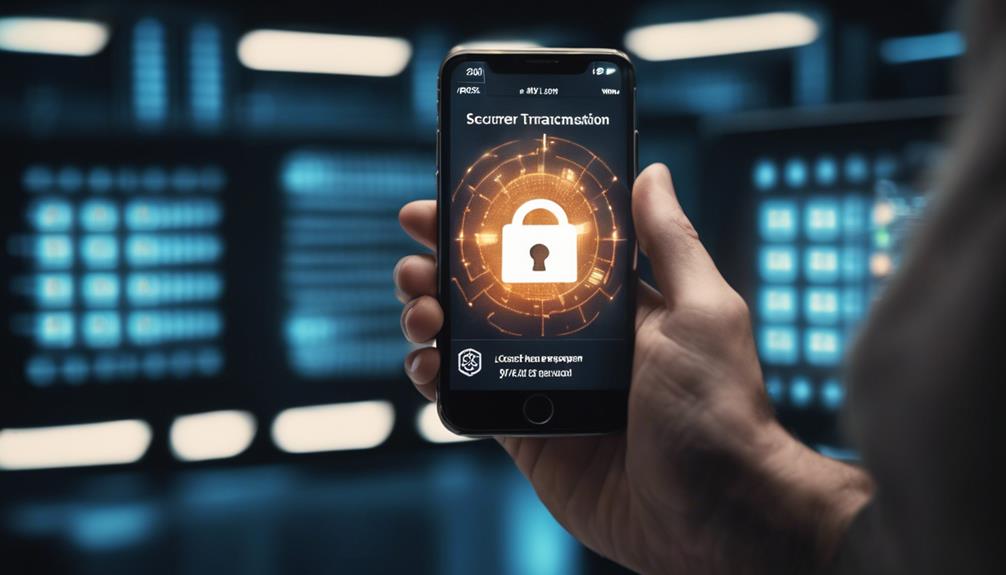To safeguard payment transactions, every payment service must follow critical security protocols. Utilize strong encryption methods like SSL/TLS for data transmission. Implement secure storage practices with encryption at rest. Regular security assessments and audits are vital to identify vulnerabilities. Enforce strict access controls to protect sensitive data. Have incident response plans in place for prompt security breach management. Comply with PCI DSS standards for data protection. Prevent fraudulent activities through advanced measures. Build trust with customers by prioritizing security. Following these protocols guarantees the integrity and confidentiality of financial information. Discover more about ensuring secure payment transactions by implementing these essential security measures.
Key Takeaways
- Implement strong encryption methods like SSL/TLS to secure data transmission.
- Adhere to PCI DSS standards for handling payment card data securely.
- Utilize tokenization technology to replace actual payment data with tokens.
- Conduct regular security assessments and monitoring to identify vulnerabilities.
- Establish robust access controls and role-based security to safeguard sensitive payment information.
Encryption Methods for Data Transmission

Ensuring secure data transmission involves implementing both symmetric and asymmetric encryption methods.
Symmetric encryption utilizes the same key for both encrypting and decrypting data, providing a fast and efficient way to secure information during transmission.
On the other hand, asymmetric encryption involves a public key for encryption and a private key for decryption, enhancing security by using a more complex key system.
SSL/TLS protocols play an important role in securing online data transmissions between customers and businesses. These protocols establish a secure connection, encrypting the data exchanged to prevent unauthorized access.
Strong encryption algorithms and effective key-management practices are essential for protecting sensitive data during transmission. Regular updates and assessments are crucial to ensuring the continued effectiveness of encryption methods, as new vulnerabilities are discovered and encryption technologies evolve.
Secure Storage Practices for Sensitive Information

To enhance the security of sensitive information, prioritize implementing secure storage practices that involve encrypting payment data at rest. By following these practices, you can safeguard valuable data from unauthorized access and potential breaches.
Consider the following key points:
- Access Controls: Implement strong access controls to guarantee that only authorized personnel can access and manage sensitive data.
- Tokenization Technology: Utilize tokenization technology to replace actual payment data with tokens, reducing the risk associated with storing sensitive information.
- Compliance Requirements: Adhere to data protection regulations such as GDPR and PCI DSS, which mandate secure storage practices for safeguarding sensitive data.
Regular Security Assessments and Audits

Regular security assessments and audits play an essential role in identifying vulnerabilities and enhancing the overall security of payment services. By conducting these assessments, organizations can guarantee compliance with industry standards such as PCI DSS requirements, ultimately safeguarding sensitive data and maintaining a secure environment. Security assessments involve thorough evaluations of systems, processes, and controls to assess the effectiveness of security measures, while audits provide insights into potential security risks, enabling proactive issue resolution. Continuous monitoring through security assessments helps mitigate security threats and protect sensitive payment data from cyber-attacks.
| Key Points | Description | Importance |
|---|---|---|
| PCI DSS requirements | Compliance with PCI DSS standards is essential for data security and trustworthiness of payment services | Ensures secure data handling |
| Security Assessments | Evaluation of systems and controls to identify vulnerabilities and strengths | Enhances overall security |
| Audits | Provide insights into security risks and help in addressing issues proactively | Ensures compliance |
| Continuous Monitoring | Ongoing assessment to mitigate security threats and protect sensitive data | Enhances cybersecurity measures |
Strict Access Controls for Data Protection

Strict access controls play a vital role in safeguarding sensitive data within payment services. Role-based access guarantees employees only have access to relevant information, bolstering overall data security.
Additionally, employing data encryption techniques adds an extra layer of protection against unauthorized access attempts.
Role-Based Access
Enhance your organization's security protocols for payment services by implementing role-based access controls to safeguard sensitive payment data from unauthorized access.
Role-based access ensures that only authorized users have specific permissions to access sensitive payment data, helping to prevent unauthorized access and reduce the risk of data breaches. By assigning roles and permissions, organizations can effectively control who can view, modify, or delete payment information, enhancing overall security measures.
Additionally, strict access controls play an important role in minimizing the potential for internal threats by limiting employee access to necessary payment information. Implementing role-based access policies is essential not only for protecting payment data but also for maintaining compliance with industry regulations.
Data Encryption Techniques
Utilize data encryption techniques to fortify access controls and protect sensitive payment information from unauthorized access. Encryption measures, such as SSL and TLS protocols, are important for securing data transmissions and preventing data breaches. Strong access controls, in compliance with the Data Security Standard (PCI DSS), play a significant role in safeguarding payment data. Encryption technologies like AES (Advanced Encryption Standard) ensure that only authorized users can access and decipher encrypted information. By implementing strict encryption measures, businesses can enhance the security of their systems and prevent unauthorized tampering with sensitive payment data.
| Encryption Techniques | Benefits |
|---|---|
| SSL and TLS Protocols | Secure data transmissions |
| AES (Advanced Encryption Standard) | Robust security for payment data |
Incident Response Plans for Security Breaches

When addressing incident response plans for security breaches, it's essential to focus on breach detection strategies, communication with stakeholders, and remediation and recovery efforts.
By establishing clear strategies for detecting breaches early on, you can minimize the impact of security incidents.
Effective communication with stakeholders ensures transparency and trust, while prompt remediation and recovery actions help mitigate the damages caused by security breaches.
Breach Detection Strategies
To strengthen your organization's defense against security breaches, implementing proactive breach detection strategies is vital. Here are some key strategies to enhance your breach detection capabilities:
- Utilize intrusion detection systems to monitor network traffic for any suspicious activities.
- Implement security event management tools to centralize security event data for better analysis.
- Guarantee rapid response and containment measures are in place to minimize the impact of security incidents.
Communication With Stakeholders
Clear communication channels are essential for promptly notifying stakeholders about security breaches and guaranteeing a coordinated response. Incident response plans outline roles and responsibilities, guiding actions during security incidents to minimize impact. These plans facilitate notifying customers, partners, and regulatory authorities about security breaches, maintaining transparency and trust.
Remediation and Recovery
Incorporating resilient incident response plans is essential for swiftly addressing security breaches and minimizing their impact on organizations.
When it comes to remediation and recovery from a security breach, consider the following critical steps:
- Prompt Detection: Immediately identify the breach to initiate the response process.
- Thorough Analysis: Investigate the breach to understand its scope and potential impact.
- Effective Containment: Isolate the affected systems to prevent further damage.
Compliance With PCI DSS Standards

Ensuring compliance with PCI DSS standards is vital for organizations handling payment card data to safeguard against potential data breaches and fraud. The Payment Card Industry Data Security Standard (PCI DSS) was established in 2004 by major credit card companies to enhance payment card data security.
Compliance with PCI DSS is essential for any entity processing, transmitting, or storing cardholder data. The standards encompass 12 requirements that address critical areas such as network security, data encryption, access control, and monitoring to create a secure payment environment. Merchants fall into four levels based on transaction volume, each with specific compliance requirements ranging from self-assessment questionnaires to external audits.
Non-compliance with PCI DSS can lead to penalties imposed by payment brands, affecting the ability to process card payments and jeopardizing data security. Adhering to PCI DSS standards isn't just a regulatory obligation but a fundamental step in protecting sensitive payment information and maintaining trust with customers.
Data Security and Privacy Commitment

When it comes to ensuring data security and privacy commitment in payment services, key points such as encryption for data protection, compliance with privacy policies, and secure payment processing stand out.
These factors play an essential role in safeguarding sensitive customer information and maintaining trust in your services. By prioritizing these aspects, you demonstrate a strong dedication to protecting customer privacy and financial data.
Encryption for Data Protection
To enhance the security of sensitive data and uphold privacy commitments, robust encryption methods are imperative in safeguarding payment transactions. Encryption, such as SSL/TLS, plays a significant role in securing data transmissions and preventing data breaches. Asymmetric and symmetric encryption techniques are commonly utilized to protect payment information and guarantee data integrity.
Regular updates and assessments of encryption protocols are essential to defend against evolving cyber threats effectively. By adhering to encryption standards like PCI DSS, companies can create a secure environment for processing payment transactions. Remember, encryption is the cornerstone of data protection, ensuring that sensitive information remains confidential and secure.
- Implement SSL/TLS encryption protocols
- Utilize both asymmetric and symmetric encryption methods
- Stay updated on encryption standards and best practices
Privacy Policy Compliance
Upon handling payment transactions securely through encryption methods, the next critical aspect to address is ensuring compliance with privacy policies regarding data security and privacy commitment. Payment services must adhere to privacy regulations to safeguard sensitive information and maintain customer trust. Clear communication of data security practices is essential to demonstrate a commitment to protecting user data. Failure to comply with privacy policies can lead to legal consequences and harm the reputation of the payment service. By implementing access control measures and upholding privacy policies, payment services can enhance security, build trust with customers, and mitigate potential risks. Check out the table below for key considerations in privacy policy compliance:
| Key Considerations | Benefits |
|---|---|
| Access Control Measures | Enhances Data Security |
| Clear Communication | Builds Customer Trust |
| Compliance with Regulations | Avoids Legal Consequences |
| Data Protection Practices | Safeguards Sensitive Information |
Secure Payment Processing
Implementing robust security protocols in secure payment processing is crucial for safeguarding sensitive customer data and preventing unauthorized access. To guarantee secure payment processing, consider the following:
- Encryption: Utilize encryption techniques to encode payment data, making it unreadable to unauthorized parties.
- Tokenization: Implement tokenization methods to replace sensitive data with unique tokens, preventing exposure during transactions.
- Authentication: Employ multi-factor authentication to verify the identity of users and secure payment transactions.
Prevention of Fraudulent Activities

Utilize advanced fraud prevention measures to safeguard payment services against fraudulent activities. Implement real-time fraud monitoring systems to detect and prevent suspicious transactions promptly. By utilizing machine learning algorithms, analyze transaction patterns and anomalies to proactively prevent fraud. Guarantee secure transactions by requiring strong customer authentication methods such as biometrics or OTPs. Regularly conduct security audits and risk assessments to pinpoint vulnerabilities and enhance fraud prevention strategies. Collaborate with industry partners to share threat intelligence and stay updated on emerging fraudulent activities.
| Fraud Prevention Measures | Benefits |
|---|---|
| Real-time fraud monitoring systems | Prompt detection of suspicious transactions |
| Machine learning algorithms | Proactive fraud prevention through pattern analysis |
| Strong customer authentication | Secure verification of transactions |
| Security audits and risk assessments | Identification of vulnerabilities for enhancement |
| Industry collaboration | Stay ahead of emerging fraudulent activities |
Protection of Cardholder Data

To guarantee the security of payment services, it's imperative to safeguard cardholder data through encryption and tokenization technologies. When transmitting cardholder data, encryption plays an essential role in ensuring that sensitive information remains secure.
Additionally, utilizing tokenization technology helps in replacing actual card details with unique tokens, adding an extra layer of protection against potential breaches. Maintaining robust network security is important to safeguard cardholder data from cyber threats and unauthorized access.
Regular monitoring and vulnerability testing of systems are critical steps to identify and rectify any weaknesses that could compromise the security of cardholder data. Adhering to PCI DSS requirements and compliance standards is fundamental in upholding the integrity of cardholder data and ensuring that all security protocols are in line with industry standards.
Trust-Building With Customers

Building trust with customers in the domain of payment services is a foundational aspect that drives loyalty and repeat business. Trust is established through transparent communication about security measures, protocols, and the protection of sensitive data. By consistently delivering secure transactions and safeguarding customer information, payment services can foster a sense of security and reliability among users. Implementing robust security protocols not only enhances credibility but also instills confidence in the service. Prioritizing customer security concerns and promptly addressing them helps build a strong foundation of trust. Access to sensitive data and its secure transmission are key components in ensuring customer security and trust. By adhering to stringent security measures and protocols, payment services can create a safe environment for transactions, ultimately strengthening the bond of trust with their customers.
| Trust-Building Strategies | Importance |
|---|---|
| Transparent communication | Enhances customer confidence |
| Consistent delivery of security | Fosters trust and reliability |
| Addressing customer concerns | Builds a strong foundation of trust |
Frequently Asked Questions
What Protocol Is Used to Make a Payment Securely?
To make a payment securely, the SSL and TLS protocols encrypt data during transactions, ensuring secure communication.
Additionally, the 3D Secure authentication protocol adds an extra layer of security by verifying the customer's identity.
Tokenization protocol replaces sensitive payment info with unique tokens, enhancing security.
Address Verification Service (AVS) confirms billing address validity.
Adherence to PCI DSS standards is essential for protecting cardholder data.
These protocols collectively contribute to a safe payment environment.
What Are the Security Considerations for Payment Gateway?
To guarantee secure transactions, payment gateways must comply with PCI DSS standards, encrypt data with SSL/TLS, and use 3D Secure for customer verification. Tokenization technology replaces sensitive data with tokens to prevent unauthorized access. Address Verification Service (AVS) confirms billing addresses to reduce fraud.
Following these protocols safeguards payment information during processing and transmission, enhancing overall security for both businesses and customers.
What Are CIS Security Standards?
CIS security standards are a set of best practices and guidelines that prioritize cybersecurity defenses. These standards offer specific configuration guidelines for securing operating systems, software, and devices.
Adhering to CIS controls helps establish a robust security posture, reducing cyber risks. Implementing these standards can enhance security measures and safeguard against common cyber threats.
Following CIS benchmarks is essential for organizations aiming to mitigate cybersecurity risks effectively and maintain a secure environment.
What Is the Protocol of Payment Gateway?
The protocol of a payment gateway encompasses secure data transmission, encryption, and authentication mechanisms. It guarantees safe online transaction processing and protects sensitive customer information.
SSL/TLS encryption plays an essential role in securing data transmissions, while 3D Secure authentication verifies customers during transactions.
Tokenization is another important protocol that replaces sensitive payment data with unique tokens for enhanced security. These elements collectively contribute to a robust payment gateway protocol.
Conclusion
Ultimately, it's essential for payment services to adhere to critical security protocols to safeguard sensitive information and protect against cyber threats. According to a recent study, 67% of consumers are more likely to trust a payment service that prioritizes data security.
By implementing encryption methods, secure storage practices, regular audits, and incident response plans, payment services can build trust with customers and prevent fraudulent activities. Prioritizing data security isn't only a necessity but also a competitive advantage in the digital age.










